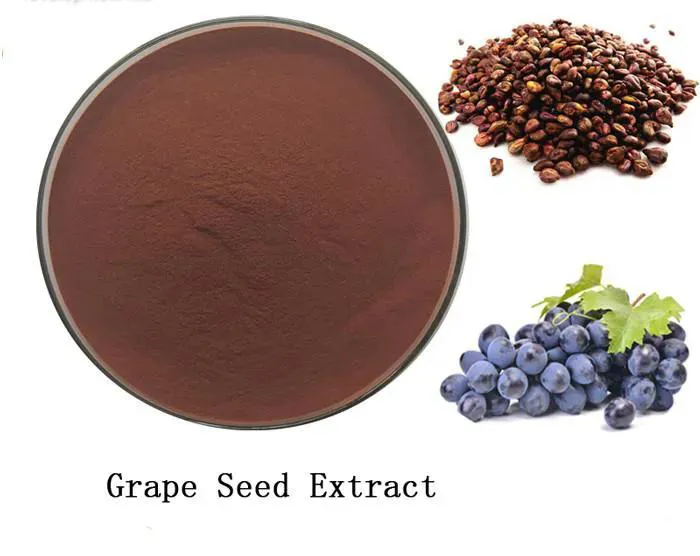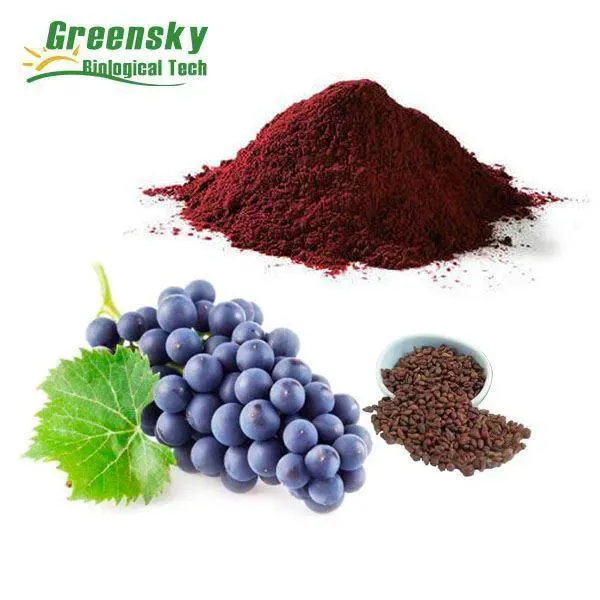- 0086-571-85302990
- sales@greenskybio.com
Evaluating the Risks: A Comprehensive Safety Profile of Grape Seed Extract
2024-08-09

1. Introduction
Grape Seed Extract has emerged as a popular supplement in recent years, touted for its potential health benefits. It is rich in antioxidants, such as proanthocyanidins, which are believed to play a role in combating oxidative stress, reducing inflammation, and potentially preventing various chronic diseases. However, as with any supplement, it is essential to understand its safety profile comprehensively. This includes not only potential side effects but also interactions with medications and long - term safety implications. By delving into these aspects, consumers and healthcare providers can make more informed decisions regarding the use of Grape Seed Extract.

2. Possible Side Effects
2.1 Gastrointestinal Disturbances
One of the most commonly reported side effects of Grape Seed Extract is gastrointestinal disturbances. These can include nausea, vomiting, diarrhea, and stomach cramps. The reasons for these side effects are not entirely clear, but it may be related to the extract's effect on the digestive system. For example, in some cases, the high concentration of antioxidants or other bioactive compounds in the extract may irritate the lining of the stomach or intestines. However, it should be noted that these side effects are generally mild and occur in a relatively small percentage of users.
2.2 Allergic Reactions
Although rare, allergic reactions to grape seed extract are possible. People who are allergic to grapes or other related products may be at a higher risk of experiencing an allergic reaction to the extract. Symptoms of an allergic reaction can range from mild, such as skin rashes, itching, or hives, to more severe, including difficulty breathing or anaphylactic shock. If an individual experiences any signs of an allergic reaction after taking grape seed extract, they should discontinue use immediately and seek medical attention.

3. Interactions with Medications
3.1 Blood - Thinning Medications
Grape seed extract may interact with blood - thinning medications, such as warfarin. The extract contains compounds that have anti - platelet and anticoagulant properties. When taken in combination with blood - thinning medications, there is an increased risk of bleeding. This interaction can be potentially dangerous, as it may lead to excessive bleeding, both internally and externally. For example, a patient on warfarin who starts taking grape seed extract without medical supervision may experience unexplained bruising, nosebleeds, or more serious bleeding episodes. It is crucial that patients taking blood - thinning medications consult their healthcare provider before starting grape seed extract supplementation.
3.2 Antihypertensive Medications
There is also evidence to suggest that grape seed extract may interact with antihypertensive medications. The extract may have a blood - pressure - lowering effect on its own, and when combined with medications used to treat hypertension, it could potentially cause blood pressure to drop too low. This can lead to symptoms such as dizziness, lightheadedness, or even fainting. Healthcare providers need to be aware of this potential interaction when prescribing medications to patients who are also taking grape seed extract or considering its use.
3.3 Other Medications
Grape seed extract may interact with other medications as well. For instance, it could potentially affect the absorption or metabolism of certain drugs in the liver or intestines. However, more research is needed to fully understand these interactions. Some drugs that are metabolized by the cytochrome P450 enzyme system may be affected by grape seed extract, as the extract may inhibit or induce the activity of these enzymes. This could lead to altered drug levels in the body, either increasing the risk of toxicity or reducing the effectiveness of the medication.

4. Long - Term Safety Implications
4.1 Oxidative Stress and Antioxidant Imbalance
While grape seed extract is known for its antioxidant properties, there are concerns about long - term use and potential oxidative stress and antioxidant imbalance. In normal physiological conditions, the body maintains a balance between antioxidants and free radicals. However, excessive intake of antioxidants, such as through long - term high - dose supplementation of grape seed extract, may disrupt this balance. This could potentially lead to an over - suppression of free radicals, which are actually necessary for certain cellular functions. For example, free radicals play a role in the immune response and cell signaling. If their levels are too low due to excessive antioxidant intake, it could have unforeseen consequences on the body's overall health.
4.2 Effects on the Liver and Kidneys
Long - term use of grape seed extract may also have implications for the liver and kidneys. These organs are responsible for metabolizing and excreting substances from the body. Some studies have suggested that high - dose or long - term use of grape seed extract could potentially cause liver or kidney damage. However, the evidence is not conclusive at this time. The mechanisms by which grape seed extract could affect these organs are not fully understood, but it may be related to its bioactive compounds and their effects on cellular metabolism and detoxification processes in the liver and kidneys. More research is needed to determine the long - term safety of grape seed extract on these vital organs.

5. Dosage and Safety
The safety of grape seed extract is also related to the dosage used. At appropriate dosages, the risk of side effects and interactions may be relatively low. However, as the dosage increases, the likelihood of experiencing adverse effects may also increase. There is currently no standardized recommended dosage for grape seed extract, as it can vary depending on factors such as the individual's age, health status, and the intended use of the supplement. In general, it is advisable to start with a low dosage and gradually increase it while monitoring for any signs of side effects. It is also important to follow the instructions provided by the manufacturer or consult a healthcare provider for personalized dosage recommendations.
6. Conclusion
Grape seed extract has the potential for various health benefits, but a comprehensive understanding of its safety profile is essential. While it is generally considered safe for most people at appropriate dosages, there are potential risks, including possible side effects, interactions with medications, and long - term safety implications. Healthcare providers should be aware of these risks when advising patients about the use of grape seed extract, and consumers should also be cautious and informed. Future research is needed to further clarify the safety aspects of grape seed extract, especially regarding long - term use and its effects on different populations. By taking these factors into account, we can ensure the safe and effective use of this popular supplement.
FAQ:
Q1: What are the possible side effects of grape seed extract?
Some possible side effects of grape seed extract may include headache, dizziness, and nausea in a small number of people. It may also cause allergic reactions in those who are sensitive to grapes or related substances. However, these side effects are not common and usually occur at relatively high doses.
Q2: Can grape seed extract interact with medications?
Yes, it can. Grape seed extract may interact with blood - thinning medications such as warfarin. Since it has antioxidant and anti - platelet properties, it may increase the risk of bleeding when taken with these medications. It may also interact with certain medications that are metabolized by the liver, potentially affecting their efficacy or increasing the risk of side effects.
Q3: Is grape seed extract safe for long - term use?
The long - term safety of grape seed extract is still an area of ongoing research. While short - term use at appropriate doses appears to be generally safe for most people, there are concerns about potential cumulative effects over a long period. For example, its effects on liver and kidney function with long - term use are not fully understood. More research is needed to establish conclusive long - term safety.
Q4: Who should avoid taking grape seed extract?
People who are allergic to grapes or grape products should avoid grape seed extract. Also, those taking blood - thinning medications without medical supervision should be cautious as it may increase the risk of bleeding. Pregnant and breastfeeding women should consult their healthcare providers before taking grape seed extract, as its safety in these situations has not been fully established.
Q5: How is the safety of grape seed extract determined?
The safety of grape seed extract is determined through a variety of methods. These include in - vitro studies to observe its effects on cells, in - vivo animal studies to look at its impact on the body of animals, and human clinical trials. These studies assess factors such as side effects, toxicity levels, and interactions with the body's normal functions. However, more research is often needed to fully understand all aspects of its safety.
Related literature
- Safety and Efficacy of Grape Seed Extract"
- "A Review on the Toxicology of Grape Seed Extract"
- "Long - term Effects of Grape Seed Extract Consumption"
- ▶ Hesperidin
- ▶ Citrus Bioflavonoids
- ▶ Plant Extract
- ▶ lycopene
- ▶ Diosmin
- ▶ Grape seed extract
- ▶ Sea buckthorn Juice Powder
- ▶ Fruit Juice Powder
- ▶ Hops Extract
- ▶ Artichoke Extract
- ▶ Mushroom extract
- ▶ Astaxanthin
- ▶ Green Tea Extract
- ▶ Curcumin
- ▶ Horse Chestnut Extract
- ▶ Other Product
- ▶ Boswellia Serrata Extract
- ▶ Resveratrol
- ▶ Marigold Extract
- ▶ Grape Leaf Extract
- ▶ New Product
- ▶ Aminolevulinic acid
- ▶ Cranberry Extract
- ▶ Red Yeast Rice
- ▶ Red Wine Extract
-
Lemon Juice Powder
2024-08-09
-
melatonin extract
2024-08-09
-
Feverfew Extract
2024-08-09
-
Grape Seed Extract
2024-08-09
-
Almond Extract Powder
2024-08-09
-
Peppermint Extract Powder
2024-08-09
-
White Willow Bark Extract
2024-08-09
-
Genistein
2024-08-09
-
Epimedium extract powder
2024-08-09
-
Lavender Extract
2024-08-09




















